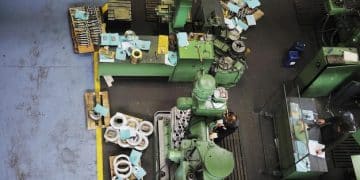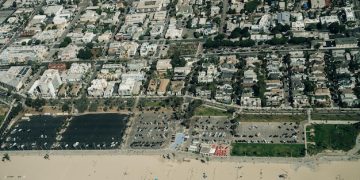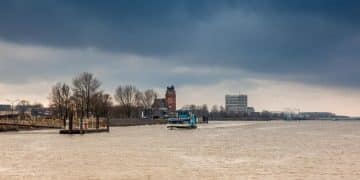The Impact of Plastic Pollution on US Marine Ecosystems: Solutions for a Cleaner Ocean
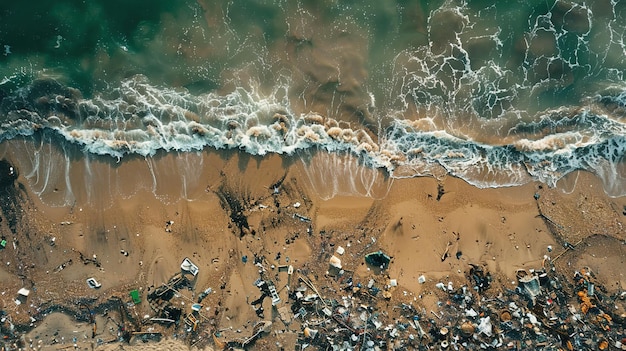
Plastic pollution significantly impacts US marine ecosystems, harming marine life through entanglement and ingestion, while recent solutions focus on reducing plastic waste through improved recycling, biodegradable materials, and policy changes.
The relentless tide of plastic waste presents a critical threat to the health and biodiversity of US marine ecosystems. Understanding
the impact of plastic pollution on US marine ecosystems is crucial for developing and implementing effective solutions to reduce plastic waste and safeguard marine life.
Plastic pollution in the United States, stemming from a combination of local and global sources, has become a pervasive environmental issue affecting over 95,000 miles of shoreline. In this article, we will cover the impact of plastic pollution on US marine environments, exploring the latest solutions and preventative measures being implemented to combat this escalating crisis.
Sources and Types of Plastic Pollution
Understanding the origins and composition of plastic pollution is essential for tackling the problem effectively. This section examines the primary sources and the diverse types of plastics that contribute to marine pollution.
Land-Based Sources
The majority of plastic pollution originates from land-based activities. Improper waste management, including inadequate recycling programs and illegal dumping, allows plastic waste to enter waterways and eventually reach the ocean. Runoff from urban areas, agricultural lands, and industrial sites also carries plastic debris into coastal waters.
Ocean-Based Sources
While land-based sources dominate, ocean-based activities also contribute significantly to plastic pollution. Fishing gear, such as nets and lines, can be lost or abandoned, becoming “ghost gear” that continues to trap marine life. Shipping and boating activities, along with offshore oil and gas operations, also release plastic waste into the marine environment.
Types of Plastics
Various types of plastics contribute to marine pollution, each with different characteristics and degradation rates. Common types include:
- Polyethylene (PE): Used in plastic bags, food packaging, and bottles.
- Polypropylene (PP): Found in bottle caps, containers, and fibers.
- Polyvinyl Chloride (PVC): Used in pipes, construction materials, and packaging.
- Polystyrene (PS): Used in disposable cups, containers, and packaging foam.
Microplastics, tiny plastic particles less than 5mm in size, also pose a significant threat. These can originate from the fragmentation of larger plastics or from direct release as microbeads in personal care products.
In conclusion, the sources and types of plastic pollution are diverse. Addressing this complex issue requires a multi-faceted approach that targets both land and ocean-based sources, as well as promotes responsible waste management and the use of alternative materials.
The Impact on Marine Life
Plastic pollution has far-reaching consequences for marine life, affecting a wide range of species and ecosystems. This section explores the direct and indirect impacts of plastic on marine organisms.
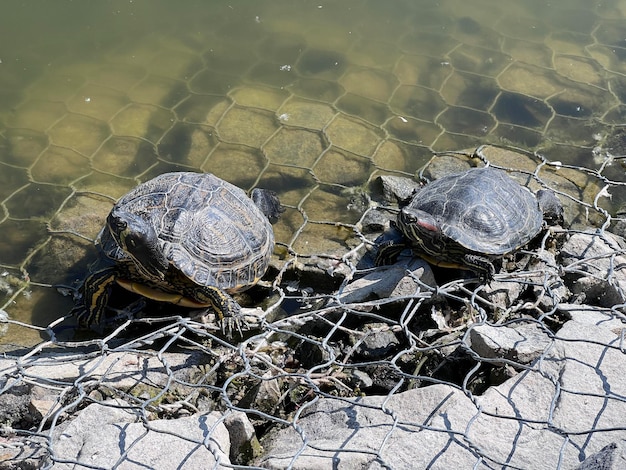
Entanglement
Marine animals, including sea turtles, seabirds, and marine mammals, often become entangled in plastic debris, particularly fishing gear such as nets and lines. Entanglement can cause injury, drowning, and starvation. Animals may struggle to free themselves, leading to exhaustion and increased vulnerability to predators.
Ingestion
Many marine species mistake plastic debris for food, leading to ingestion. Ingesting plastic can cause internal injuries, block digestive tracts, and reduce the nutritional value of consumed food. Seabirds, for example, often feed plastic to their chicks, resulting in reduced growth rates and increased mortality.
Habitat Destruction
Accumulations of plastic debris can smother habitats, such as coral reefs and seagrass beds. Plastic can also alter the physical and chemical properties of sediments, affecting the organisms that live in these environments.
Impacts on the Food Chain
Plastic pollution can disrupt the marine food chain. Microplastics, in particular, can be ingested by small organisms, such as plankton, which are then consumed by larger animals. This can lead to the accumulation of plastic in the tissues of marine organisms, potentially affecting their health and reproductive success.
The latest research
Recent studies have shown that plastic pollution can also facilitate the spread of invasive species by providing a substrate for them to attach to and travel long distances. This can lead to further disruptions in marine ecosystems.
In sum, plastic pollution causes harm to marine life including entanglement and ingestion. Tackling this issue requires efforts to reduce plastic waste. We need better waste management and promote the use of alternative materials.
Economic Consequences
The adverse impacts of plastic pollution extend beyond the environment, affecting various sectors of the US economy. This section examines the economic costs associated with marine plastic pollution.
Tourism
Plastic pollution can deter tourists from visiting beaches and coastal areas, leading to reduced revenue for the tourism industry. Clean-up efforts, such as beach cleanups, also incur significant costs.
Fisheries
Plastic pollution can negatively impact fisheries by reducing fish stocks and contaminating seafood. Entanglement and ingestion of plastic can lead to reduced populations of commercially important fish species. Contamination of seafood with microplastics also raises concerns about human health.
Shipping and Navigation
Plastic debris can damage boats and ships, leading to increased maintenance costs and potential disruptions to navigation. Clearing plastic from waterways and harbors also requires significant resources.
Waste Management
Managing plastic waste requires substantial investments in collection, sorting, and recycling infrastructure. The cost of disposing of plastic waste in landfills is also increasing as landfill space becomes limited.
Property Values
Coastal properties can decline due to plastic pollution, reducing property tax revenues for local governments. The aesthetic value of coastal areas is diminished by the presence of plastic debris.
In conclusion, the economic consequences of plastic pollution are far-reaching and can affect tourism, fisheries, shipping, and navigation. Efforts to reduce plastic waste and improve waste management can lead to economic benefits.
Policy and Regulations
Effective policies and regulations are essential for addressing plastic pollution and promoting sustainable practices. This section examines the existing and potential policy interventions to combat marine plastic pollution in the US.
Federal Legislation
The US federal government has implemented several laws and regulations to address plastic pollution. The Marine Plastic Pollution Research and Control Act aims to reduce plastic waste generated by vessels and shore-based facilities. The Microbead-Free Waters Act prohibits the use of microbeads in personal care products.
State and Local Initiatives
State and local governments have also implemented policies to reduce plastic waste. Many states have banned single-use plastic bags or implemented fees on their use. Some cities have banned polystyrene foam containers and promoted recycling programs.

Extended Producer Responsibility (EPR)
EPR policies hold producers responsible for the end-of-life management of their products, including plastic packaging. EPR programs can incentivize producers to design products that are easier to recycle and reduce the amount of plastic waste generated.
International Agreements
The US participates in international agreements to address marine plastic pollution, such as the MARPOL Convention, which prohibits the discharge of plastic waste from ships. The US also collaborates with other countries to promote research and share best practices for reducing plastic waste.
The future of policies
The effectiveness of policies and regulations will depend on their enforcement and implementation. It is important to ensure that policies are based on scientific evidence and are regularly evaluated to determine their effectiveness.
To sum up, regulations by federal, state, and local governments are key. International agreements and collaborations are also important for promoting policies that reduce the pollution.
Technological Innovations
Technological innovation plays a crucial role in addressing plastic pollution by developing new methods for waste management, recycling, and alternative materials. This section examines some of the latest technological advancements in this field.
Advanced Recycling Technologies
Advanced recycling technologies, such as chemical recycling, can break down plastic waste into its original building blocks, allowing it to be used to create new plastic products. These technologies can recycle plastics that are difficult or impossible to recycle using traditional methods.
Biodegradable and Compostable Plastics
Biodegradable and compostable plastics are made from renewable resources and can break down naturally in the environment. These materials can reduce the amount of plastic waste that ends up in landfills and the ocean.
Plastic Capture Technologies
Plastic capture technologies are designed to remove plastic debris from waterways and the ocean. These technologies include floating barriers, drones, and robotic systems.
Waste-to-Energy Technologies
Waste-to-energy technologies can convert plastic waste into energy, reducing the amount of waste that ends up in landfills. These technologies can also reduce greenhouse gas emissions by replacing fossil fuels.
Nanomaterials
Nanomaterials can strengthen plastics and reduce the amount of material needed for packaging. They can also make plastics more durable and resistant to degradation.
In conclusion, advancing technology is key to managing the plastic pollution, and can make plastics more durable. This allows more access for recycling programs and technological advancement.
Community Engagement and Education
Community engagement and education are essential components of any successful effort to combat plastic pollution. This section examines the role of individuals, communities, and organizations in promoting responsible plastic use and waste management.
Individual Actions
Individuals can reduce their plastic footprint by making conscious choices about their consumption habits. These include:
- Reducing the use of single-use plastics, such as plastic bags, bottles, and straws.
- Recycling properly and participating in local recycling programs.
- Choosing products with minimal packaging or packaging made from sustainable materials.
- Supporting businesses that are committed to reducing plastic waste.
Community Initiatives
Communities can organize cleanup events, promote recycling programs, and advocate for policies that reduce plastic waste. Community gardens and farmers’ markets can reduce the need for packaged food.
Educational Programs
Educational programs can raise awareness about the impacts of plastic pollution and promote responsible behavior. Schools, universities, and community organizations can conduct workshops, seminars, and outreach events to educate the public.
Partnerships
Partnerships with community organizations can drive engagement for solutions that reduce plastic consumption and the impact plastic has by:
- Organizing outreach events to spread awareness of problems caused by plastic
- Hosting community projects
- Conducting educational campaigns
In summary, community engagement and education are essential for promoting responsible plastic use and waste management. Support programs in communities and implement outreach events.
| Key Point | Brief Description |
|---|---|
| 🌊 Marine Impact | Entanglement, ingestion, and habitat destruction harm marine life. |
| ♻️ Recycling Tech | Advanced recycling transforms plastic into usable materials. |
| 🌱 Eco-Friendly Plastics | Biodegradable plastics help reduce the plastic waste footprint. |
| 🛡️ Policy & Law | Laws that address plastic use such as reduced plastic bags and bans of polystyrene. |
Frequently Asked Questions
▼
The main sources are land-based activities like improper waste management, runoff from urban and agricultural areas, and ocean-based activities like fishing gear and shipping.
▼
Plastic pollution harms animals through entanglement, ingestion, and habitat destruction. Microplastics also disrupt the food chain.
▼
Federal, state, and local governments are implementing policies like plastic bag bans, fees, and extended producer responsibility programs to reduce pollution.
▼
Innovations like advanced recycling, biodegradable plastics, plastic capture technologies and nanomaterials are helping to reduce and manage the pollution.
▼
Individuals can reduce single-plastic use, recycle, and support businesses committed to sustainability. Communities can organize cleanup events and promote behavior.
Conclusion
Addressing the escalating crisis of plastic pollution within US marine ecosystems demands a comprehensive and collaborative approach. By integrating community action and education, the combined efforts can lead to more responsible and effective plastic usage. Continued research, innovative technological advancements, and strict policy enforcement are critical in finding sustainable solutions. Together, these actions can promote a healthier marine environment for future generations.

